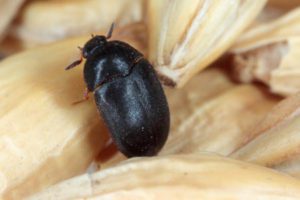BLACK DOTS CLIMBING WALLS COULD BE CARPET BEETLES!
By Zachary Ciras on March 10, 2020.
You probably didn’t even know you had carpet beetles in your home. But lately, you keep seeing tiny, black dots moving slowly up walls and you’ve found a few dead insects on the windowsill, too. Without prior experience, about the only way to determine that these are carpet beetles is with a professional identification. Since adult carpet beetles are not often found in the same sites as the larval form, you wouldn’t associate any fabric damage found in your home with these wall-climbing beetles.
ADULT CARPET BEETLES JUST WANT TO GET OUTSIDE
The reason that carpet beetles are on the move in early spring is that they are programmed to get outside to early flowering plants, which is their natural feeding and breeding site. Unlike their larval form, the adult beetles do not feed on wool, furs, hides, lint, feathers, dead insects, etc. Instead, they feed on flower pollen and nectar. Also different than the larval stage, the adult beetles are attracted to light when they emerge from the pupal cocoon – and that is why they climb walls heading for windows.
Normally, carpet beetles would mate outside and then, when looking for a suitable dark place to lay eggs, the female may find her way into a home (or may be carried in on cut flowers). However, most carpet beetles have largely become indoor dwellers and are able to mate and carry on without that outdoor flower connection.
LARVAL CARPET BEETLES JUST WANT TO HIDE…AND EAT

Black Carpet Beetle. Shutterstock.
Carpet beetle larvae, on the other hand, shun light and can be difficult to find hiding in corners, under furniture, on the underside of wool rugs, behind baseboards, and in other dark, undisturbed locations. The ¼-inch long larvae have short legs and rows of bristly hairs and frequently shed their skins in order to grow (see Meet the Carpet Beetles). In hiding, they feed on fibers and fabric, or more often on an accumulation of pet hair, dead insects, food crumbs, and whatever is overlooked during cleaning. Most indoor carpet beetle infestations are simply a result of less than fastidious vacuuming, especially in a home with pets.
CARPET BEETLE LARVAE ARE HARD TO FIND
Most homes have at least a few unnoticed carpet beetles slowly developing in out-of-the-way places. A pest control professional knows where to find them, in case you were acting smug about being carpet beetle-free. You may never notice carpet beetles unless you happen to see active adults in spring. For example, you often can’t even see carpet beetle feeding damage to a wool rug – until you turn it over to find larvae, their shed skins, and irregular damaged areas without nap underneath (See What Are the Signs of Carpet Beetles?).
When the beetles are infesting individual items such as rugs, clothing, trophy heads, or furs, the item is usually discarded, dry cleaned, or otherwise professionally treated. When carpet beetles are allowed to feed unnoticed and accumulate over time, damage to an item can be extensive and you can have separate infestations in many areas in your home.
But, for most carpet beetle infestations, a thorough targeted vacuuming, paying special attention to corners, baseboards, under furniture, and other undisturbed places where debris and hair accumulate can help eliminate carpet beetles and the household “lint” that they feed on.
If you have little round beetles climbing your walls, better give Colonial Pest a call!
For more on carpet beetles, check out these blogs: